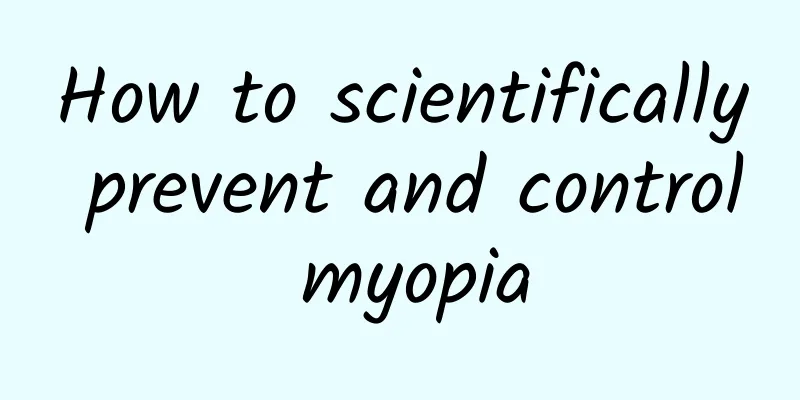How to scientifically prevent and control myopia

|
Author: Xiang Yan: Deputy Chief Physician of Tongji Hospital, Tongji Medical College, Huazhong University of Science and Technology Reviewer: Yang Hong, Chief Physician, Tongji Hospital, Tongji Medical College, Huazhong University of Science and Technology Xiang Yan, Department of Ophthalmology, Tongji Hospital, Tongji Medical College, Huazhong University of Science and Technology At present, myopia is prevalent among children and adolescents, and the incidence of high myopia has increased significantly. Excessive elongation of the eye axis in people with high myopia often leads to retinal diseases such as retinal degeneration, holes, and even retinal detachment and hemorrhage, which can lead to irreversible visual damage or even blindness. In the near future, high myopia will become the leading cause of irreversible blindness. Therefore, it is very important to prevent and control the progression of myopia to high myopia, and the means mainly include the following four aspects: 1. Increase outdoor activities Outdoor activities are the most economical and effective measures to prevent myopia. : Outdoor activities are not limited to outdoor sports. Whether it is outdoor sports, outdoor picnics, or even reading and writing, they are all beneficial to prevent myopia. The reason is that light can stimulate the retina to release dopamine, and dopamine helps to delay the growth of the eye axis, thereby preventing and delaying the development of myopia. Outdoor light exposure for at least 2-3 hours a day and 14 hours a week is effective in preventing myopia, and intermittent exposure is better than continuous exposure. Therefore, it is a very good measure for children to increase the frequency of outdoor activities, such as extracurricular sports activities, outdoor rest during class breaks, and walking to school. In addition, simulating a bright outdoor learning environment when studying indoors is also conducive to preventing myopia. Figure 1 Copyright image, no permission to reprint 2. Reduce close-up use of the eyes Reducing close-up eye use is an important measure to prevent myopia, such as reducing the use of mobile phones, iPad tablets, computers, televisions, etc. Generally, the smaller the screen and the closer the distance, the greater the impact on vision. For example, mobile phones have the greatest impact. Therefore, children should be prevented from playing games on mobile phones. The writing posture should be based on three "ones": eyes should be one foot away from the book, chest should be one fist away from the desk, and pen should be one inch away from the tip of the pen, to ensure that the eye distance is relatively far. At the same time, follow the 20-20-20 principle. Teachers and parents should pay attention to formulating a reasonable study plan for children, with a proper balance between tension and relaxation. Generally speaking, after reading at close range for 40 minutes, you should take a break and look into the distance for 10 minutes. At the same time, children are also required to look into the distance intermittently when studying homework, following the 20-20-20 principle, that is, using the eyes continuously for 20 minutes-looking into the distance for 20 feet (6 meters)-for 20 seconds, which is conducive to preventing and reducing the occurrence of myopia, and is more conducive to preventing myopia. Figure 2 Copyright image, no permission to reprint In addition, you should reduce close-up eye activities, such as painting, playing the piano, and increase sports that promote eye adjustment, such as table tennis and badminton. Eating a balanced diet, promoting muscle strength, eating less sweets, and promoting the thickness and toughness of the eyeball wall are also helpful in preventing myopia. 3. Low-concentration atropine or orthokeratology lenses to control myopia progression: Low concentration (0.01%) atropine: Studies have confirmed that low concentration (0.01%) atropine has the effect of preventing the growth of the eye axis and controlling the development of myopia. Its control effect is about 60%, which is suitable for children with relatively fast myopia progression, especially for young children who cannot cooperate with wearing orthokeratology lenses. The method of use is to drop one drop every night for continuous use, and generally do not stop using it at will to prevent myopia rebound, but 0.01% low concentration atropine is not effective for everyone. It has been confirmed that 10% to 15% of myopic patients do not respond to it, and it is not effective for some children with poor eye accommodation. In addition, although its side effects are relatively small, there are still complications such as weakened accommodation, photophobia in some children, blurred vision of near objects, and possible dry eyes after long-term use. Therefore, it is recommended to use it under the supervision of a doctor. Orthokeratology: Orthokeratology is a special high-oxygen-permeable hard corneal contact lens. Studies have shown that orthokeratology is an important means for children to control myopia. It can control myopia by improving peripheral retinal defocus. The effectiveness ranges from 40% to 90%, with certain individual differences, and the overall effectiveness is about 60%. It is suitable for children over 8 years old who can cooperate with fitting; patients with rapid myopia progression (>0.75D/year), degree within 600 degrees, and appropriate corneal morphology. Patients without other eye and systemic diseases, such as dry eyes, allergic conjunctivitis, strabismus, amblyopia, etc., parents and children have good compliance, and those who can wear and care in a standardized manner can consider orthokeratology to control the development of myopia. 4. Popularize vision screening and establish refractive records. Children's hyperopia reserve is very important: School-age children: Schools should conduct vision screening regularly every 6 to 12 months. If possible, it is best to go to a medical institution to record the axial length, refractive power (dilate the pupil to understand the hyperopia reserve status), corneal curvature, intraocular pressure, eye position, height, and establish an eye refractive file. Figure 3 Copyright image, no permission to reprint Hyperopia reserve is very important for school-age children. Normal hyperopia still exists at the age of 8 years old +1D. Hyperopia reserve predicts the occurrence of myopia better than visual acuity. Children whose hyperopia reserve is very small or has disappeared will soon become myopic despite normal visual acuity. Therefore, it is very important to understand their hyperopia reserve status and axial length to facilitate early intervention and prevention. |
<<: Chitika: Data shows that Nexus tablet traffic is likely to surpass Amazon Kindle Fire
Recommend
How to supplement slow growth in early pregnancy
The early stages of pregnancy are a period of rap...
What are the ways to maintain the uterus?
No matter what you do, you have to use good metho...
Is it okay for pregnant women to eat MSG all the time?
Pregnant women pay more attention to their diet d...
What are the symptoms of postpartum bladder prolapse?
Bladder prolapse is the most common problem in po...
What are the manifestations of cervical intrauterine adhesions during B-ultrasound
Generally speaking, under normal circumstances, t...
What is the solution for small blisters caused by inflammation on the vulva?
When people get angry, they will have many uncomf...
Why is my belly hard after cesarean section?
Some female friends who have just become mothers ...
What to eat to relieve vomiting in early pregnancy
Women who have had children know that pregnancy r...
Can exercise offset the harm of staying up late?
As the concept of fitness becomes more popular, m...
If tachycardia occurs after taking dipine, take Lol to counteract it. Be careful not to reduce the dosage too quickly.
A friend with high blood pressure told Huazi that...
One week pregnant, stomach pain
After a woman becomes pregnant, her body function...
Scarf knitting pattern
There are many ways to knit a scarf. Many friends...
What causes itchy vagina in girls?
It is embarrassing for women to have itchy genita...
Disadvantages of drinking burdock tea for women
Burdock tea is a pure natural health care product...
How long does it take for urethritis to be relieved by drinking water?
Generally speaking, women's urethritis is rel...









